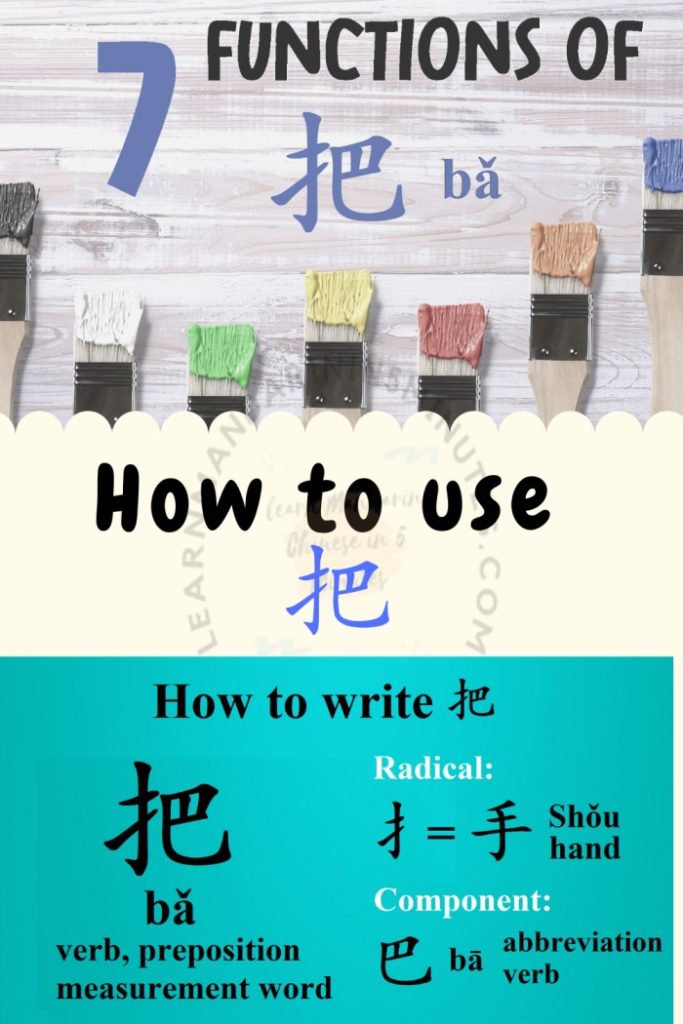The Chinese word 把 bǎ has the meaning of to hold, to contain, to grasp, to take hold of, handle in English.
把 bǎ is a verb, a preposition and a measurement word.
The radical for this Chinese word is 扌, which means 手 hand. The component is 巴, which is a verb or an abbreviation.

What is the function of 把 bǎ ?
In a 把 bǎ sentence, an action by someone or something expressed by the verb causes the object to bring about a result or a change of some kind.
1. The subject in a 把 sentence must be the doer of the action
For example,
我把衣服烫了。
wǒ bǎ yī fú tàng le
I ironed the clothes
我 = subject
把 = preposition
衣服 = object
烫 = verb
了 = predicate
It was I who ironed the clothes, and I have finished doing it, denoted by 了.
The normal form is 我烫衣服了。Wǒ tàng yī fú le. I ironed the clothes ( action finished)
2. The object in a 把 sentence is the receiver of an action indicated by the verb predicate
For example,
他把电视机弄坏了。
tā bǎ diàn shì jī nòng huài le.
He broke the TV.
In this sentence, the object or the receiver of an action is the TV.
The normal form is 他弄坏电视机了。
3. The predicate in a 把 bǎ sentence must be a transitive verb 及物动词. A verb that can influence the object of 把
For example,
玛丽把房子卖了。
mǎlì bǎ fáng zi mài le.
Mary sold the house
Normal sentence: 玛丽卖房子了。Mǎlì mài fáng zi le
The object of 把 here is 房子. 卖了 is the predicate and 卖 is a transitive verb.
玛丽把头发烫了。
mǎlì bǎ tóu fa tàng le.
Mary permed her hair.
Normal sentence: 玛丽烫头发了。
The object of 把 here is 头发. 烫了 is the predicate and 烫 is a transitive verb.
4. The verb in a 把 bǎ sentence must contain another element, which may be a directional complement, a complement of manner, an aspect particle etc. Regardless of type, the element following the verb expresses the result of an action.
For example,
他把车洗得很干净。
tā bǎ chē xǐ dé hěn gān jìng.
He washed the car very clean.
干净 – the complement of state (状态补语 zhuàng tài bǔ yǔ)
他把剩饭剩菜放进冰箱里去了。
tā bǎ shèng fàn shèng cài fàng jìn bīng xiāng lǐ qù le .
He put the leftovers in the refrigerator.
进去 – a directional complement (趋向补语 qū xiàng bǔ yǔ)
别把照片烧了,留着做个纪念吧。
Bié bǎ zhào piàn shāo le, liú zhe zuò gè jì niàn ba.
Don’t burn the photos, keep them as a remembrance.
着 – aspect particle (动态助词 dòng tài zhù cí)
5. The object in a 把 bǎ sentence is normally definite
In a 把 sentence, the listeners know what the object is referring to. If they don’t, then it cannot be the object in a 把sentence.
公司明天休息,我已经把这消息告诉顾客们了。
Gōng sī míng tiān xiū xí, wǒ yǐ jīng bǎ zhè xiāo xī gào sù gù kè men le.
The company will be closed tomorrow. I have already told the customers the news.
把这喜帖交给彼得吧。
Bǎ zhè xǐ tiě jiāo gěi bǐ dé ba.
Give this wedding invitation to Peter.
6. In a 把 bǎ sentence, negative adverb (否定副词 fǒu dìng fù cí), time words (时间词语 shí jiān cí yǔ) and modal verb (能愿动词 néng yuàn dòng cí) are placed before 把
不把功课做完,不准看电视。
bù bǎ gōng kè zuò wán, bù zhǔn kàn diàn shì.
If you don’t finish homework, you can’t watch TV.
他没把钱包带来。
Tā méi bǎ qián bāo dài lái.
He did not bring his wallet.
我能把这些食物吃完。
wǒ néng bǎ zhè xiē shí wù chī wán.
I can finish all these food.
你应该把真相告诉他。
nǐ yīng gāi bǎ zhēn xiàng gào sù tā.
You should tell him the truth.
昨天我把房间整理了。
Zuó tiān wǒ bǎ fáng jiān zhěng lǐ le.
I cleaned up the room yesterday.
7. When the verb is followed by a directional or a complement of result, such as 在 zài, 到 dào, 给 gěi, 作 zuò, 成 chéng, you can only use or it is better to use 把 ba sentence because it allows the object to be expressed.
小明把自行车停在校园外。
Xiǎo míng bǎ zì xíng chē tíng zài xiào yuán wài.
Xiao ming parked his bicycle outside the school campus.
他把辞典借给我了。
tā bǎ cí diǎn jiè gěi wǒ le.
He lent me the dictionary.
请你把菜端到桌子上。
qǐng nǐ bǎ cài duān dào zhuō zi shàng.
Please bring the dishes (food) to the table.
他把英文书翻译成汉语。
tā bǎ yīng wén shū fān yì chéng hàn yǔ.
He translated the English books into Chinese.
我把糖当作盐了。
wǒ bǎ táng dàng zuò yán le.
I mistook the sugar for salt.
Note:
Verbs that indicate existence, relationship, directional or psychological state cannot be used in 把 bǎ sentence.
有, 存在, 是, 属于 yǒu, cún zài, shì, shǔ yú
知道, 赞成, 觉得, 同意 zhī dào, zàn chéng, jué dé, tong yì
离开, 到达, 上来, 下去lí kāi, dào dá, shàng lái, xià qù
For example,
我知道他喜欢什么。wǒ zhī dào tā xǐ huān shén me. I know what he likes. (correct sentence)
我把他喜欢什么知道。(incorrect sentence)
他下去推车。tā xià qù tuī chē. He got out to push the car. (correct sentence)
他把推车下去。(incorrect sentence)
If you find this post useful, do share! For video presentation of this post, please click here. Do subscribe to our youtube channel if you are interested in learning the pronunciations.
